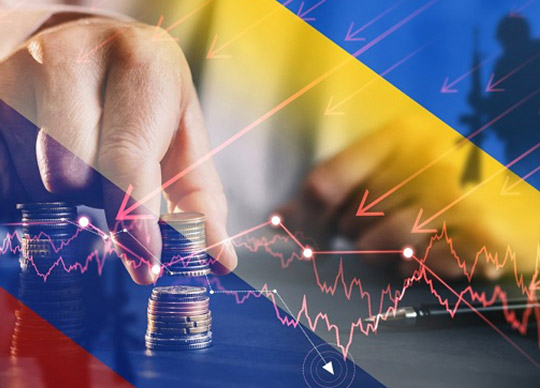
Written by Antonio Graceffo.
Although economic sanctions have played a role in warfare since the American Revolution, the Ukraine War has seen it taken to a new level.
The United States has rallied its allies to confront Washington’s oldest enemy, to try to win without firing a shot.
And while the Russian economy trends steadily downward, China’s President Xi Jinping stands by and watches. The success of economic warfare in this conflict suggests that economics will play a major role in all future wars.
Before Russia invaded Ukraine, on February 24, 2022, firepower analysts expected Russia to easily defeat the much smaller nation.
These types of forecasts, however, underestimated the economic dimension of modern warfare.
Once the invasion was launched, U.S. President Joe Biden made good on his threat to hit Putin with economic sanctions, “like none he’s ever seen or ever have been seen.”
More than punitive, the sanctions were meant to cripple the Kremlin’s ability to wage war.
Russia only managed to weather the first year of sanctions because of its unique economic conditions.
Before the war, Russia had very little foreign debt, with a total debt-to-GDP of just 16.99 percent. To put this number in perspective, China’s debt to GDP ratio is roughly 300 percent.
The Kremlin had high foreign currency reserves of $631 billion, and Russia had already diversified its holdings, with only 16 percent held in dollars and $90 billion held in gold.
Through most of the first year of the war, it looked as if the sanctions were having little or no effect, as Russia was still permitted to export oil at soaring market prices.
Export bans, preventing the sale of goods to Russia, were immediate, while bans on Russian imports were slower to materialize. By spring 2022, Russia’s imports had dropped by 43 percent.
With less money going out and more than usual coming in, due to record high oil prices, Russia was happily weathering the storm, with a growing GDP and trade surplus.
Everything changed in December, however, when Russia was hit by a trifecta of economic disruption.
The government booked its war expenses onto its balance sheets, the oil price-cap system went into effect, and the market price of oil dropped.
Russia’s economy ended the year with negative growth, and this year promises to be even worse.
When the Ukraine war first broke out, the US was quick to impose export bans, designed to hinder Russia’s ability to rebuild, repair, or maintain weapons and other military equipment.
So far, 37 countries — among them all of the world’s top economies, with the exception of China — have agreed to participate in the sanctions. Russia’s semiconductor or chip imports are down 70 percent.
Machine parts are wearing out and replacements are not readily available. In February 2023, Russia asked for a loosening of the sanctions because of a shortage of aviation parts.
Turkey and some other countries are helping Russia bypass sanctions, but shortages are growing.
Meanwhile, war casualties are also taking their toll. It is estimated that 6,000 of Russia’s military vehicles, tanks and armoured personnel carriers that were damaged in fighting last year have not been repaired and will not be redeployed.
At the same time, the International Institute for Strategic Studies estimates the Russia has lost half of its prewar stock of T-72 and T-80 battle tanks.
Replacement tanks will have to be manufactured, but this is proving problematic. Not only is Russia running out of parts, but they are also suffering a shortage of workers.
Russia’s private sector workforce has been declining steadily. During the first year of the war, public-sector employment increased by 300,000, drawing workers away from private companies.
Between 500,000 and one million Russians have fled the country. At least 300,000 men, aged 22 to 50, have been mobilized and sent off to fight. As many as 270,000 have been wounded or killed in Ukraine and will need to be replaced.
In early January, Putin announced plans for the mobilization of an additional 200,000 men. A second round of conscription will most likely accelerate the number of men leaving the country, further decimating the workforce.
Worker shortages are already being felt in the Uralvagonzavod tank factory in Western Siberia, where plans to build a second production line for T-90 battle tanks have been postponed.
Western banks froze nearly half of Russia’s foreign currency reserves, about $300 billion, while many of Russia’s biggest banks were banned from international transactions.
Russian financial institutions were excluded from SWIFT, the American-controlled international payment system.
Initially, the ruble tumbled, and it looked like the Russian economy would soon collapse. Instead, however, the currency recovered and GDP continued to grow, largely buoyed by soaring oil prices.
On December 5, 2022, however, the oil cap went into effect, limiting the price Washington-aligned nations would pay for Russian oil to $60 a barrel.
As a means of enforcement, allied ships and insurers also agreed not to handle Russian oil shipments which sold for more than the cap price.
Russian government spending increased 25 percent during 2022. In December, energy export revenue dropped by 46 percent and the Kremlin was facing a $25 billion deficit for a single month.
To make ends meet, in January, the Kremlin withdrew $38 billion from the national wealth fund. Russia can still earn money by selling oil below the price cap of $60.
Theoretically, it could also bypass restrictions, selling at a higher price to countries which do not participate in the cap, but Western companies control 90 percent of the shippers and insurers that would be needed to make those sales possible.
As a result, in January, Russian oil was selling for an average price of $52.20 per barrel, while the price it can get for liquid natural gas has dropped by 70 percent.
Non-oil and gas revenues were down 20 percent in October. Most of Russia’s systems for manufacturing and moving finished goods are focused on Europe, which now is largely off-limits to Russian trade.
Russia may still trade with Central Asia, China, and Mongolia, but trade volumes for the non-energy sector are low and transportation and logistics are not as developed as those connecting Russia with Europe.
GDP figures remained high for most of last year, as did spending on industrial production, but this was because of increased manufacturing of weapons and military equipment.
Every dollar spent on war production, however, is a dollar which could have been spent on the civilian population.
According to the Kremlin’s annual budget, government spending on the economy has declined from 4.5 trillion rubles in 2022 to 3.5 trillion in 2023.
This means that the standard of living of the average Russian is dropping. Retail spending is down 9.3 percent.
Foreign automakers have left the country and parts and labor are becoming scarce, causing a retraction in civilian auto manufacture of 67 percent, while new car sales have dropped by 59 percent.
Civilian construction projects have ground to a halt, with the sector declining over 14 percent compared to 2021.
This year, analysts expect Russia’s budget deficit to be 5 percent, but it could turn out to be much worse.
In January, revenues had fallen by about one third, while spending was 58 percent higher than a year earlier, and Russia had already hit a record deficit of 1.8 trillion rubles ($24.6 billion).
Projections for a soft landing and modest GDP growth in Russia this year were based on an oil price of $70 a barrel. Currently, Russia is receiving an average of $52 a barrel. And this price may drop even further.
As a result, the European Union expects Russia’s GDP growth to be negative, around -5.6 percent.
The impact of the sanctions and the effectiveness of the economic warfare waged on Russia is something the world has never seen before.
In the past, U.S. economic sanctions were against small, economically weak countries such as Iran, North Korea, and Cuba — but the Ukraine war marks the first time the U.S. has targeted a major world power, and with unprecedented ferocity.
In the early days, it seemed China would support Russia and the two would form a bloc against the U.S. and Western countries.
Instead, very quickly Beijing began backing off from its overt support of Russia for fear of incurring secondary sanctions.
And now, while China is helping a bit, and countries such as Iran, Syria, India, and Myanmar continue to trade with Russia, Moscow has effectively been kicked out of the global economy.
Many analysts believe that China’s long-expected invasion of Taiwan has been deterred by fear of similar sanctions being imposed on Beijing.
Russia has only survived because it possesses a number of advantages which China does not. China, unlike Russia, only has about $120 billion worth of gold (65.12 million ounces at a price of $1,842/ounce).
China has astronomical public debt. And while it has larger foreign currency reserves than Russia, one third to one half are in U.S. dollars or dollar equivalents.
Russia has been able to insulate itself somewhat by agreeing to use yuan for some of its trade with China and to increase its holding of yuan.
But what currency would China use to similarly decrease its dependence on dollars and euros? The U.S. was so successful in the war of sanctions because it was able to build a coalition against Russia.
But China has no coalition. Beijing’s largest somewhat-ally is Russia, and Moscow will not be able to save China from a similar fate.
The blueprint has been set, and economics will play a pivotal role in future wars. The Ukraine war serves as a warning to other nations. If the world’s number-two economy doubts its ability to survive similar sanctions, what nation could?






